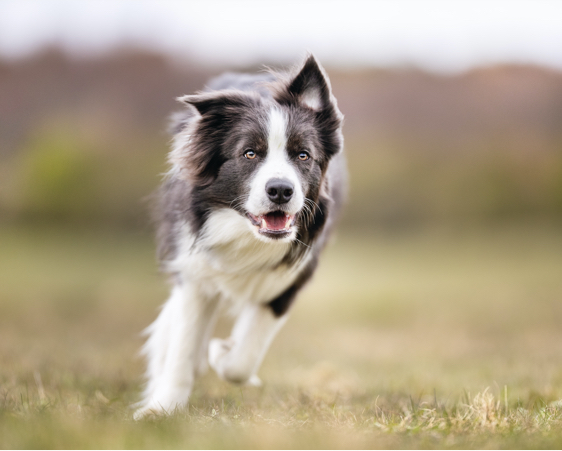When you say, “It’s time to walk the dog,” many people assume that your pup needs to go do his “business”. Yes, walking the dog is essential to keeping the household carpet unblemished, but taking a stroll with your pooch provides many other benefits.
How does walking keep my dog healthy?
Walking your dog is a simple task that has a positive impact on many aspects of overall health such as:
Weight and Body Condition. Obesity is a major health issue, but barring medical complications, it has a reasonable solution: burn more calories than consumed. Regular exercise, like walking, is a good way to burn those excess calories and keep the pounds off – for both you and your dog.
Joint Health. Immobility is another common health problem. Joints, even old ones, need to work. People and pets get stiff when sedentary for too long, and keeping joints in motion improves their function.
Digestive and Urinary Health. Regular walking helps regulate the digestive tract. Some dogs, like some people, prefer to “go” on a schedule, and providing your dog with routine trips outdoors prevents constipation. Also, when urine sits in the bladder for long periods of time, bladder infections are more likely to occur, so regular emptying keeps this part of the anatomy happy as well.
Of course, it is important to consult your doctor and your veterinarian before embarking on an exercise program.
Can’t my dog get all of those benefits with a good run around the yard?
There are plenty of benefits to walking that go beyond physical health including:
Mental Health. Dogs do not like to be bored and if you give them something constructive to do, like taking a walk, they may be less likely to do something destructive, like chewing the couch. Walking exercises the mind as well as the body. Watching wildlife, exploring new paths, seeing other people with their pets, and so on, are great mental stimulation for your dog that he just cannot get in the same fenced area all the time. Walking also releases excess energy and helps dogs sleep better at night.
Emotional Health. You are the center of your dog’s universe and he craves your attention. What better way to spend quality time with your dog than taking a walk? Spending one-on-one time with your dog will deepen your bond and help deter annoying, attention- seeking behaviors such as excessive barking or whining.
Personal Health. Many people need outside motivation to work out, and may depend on an exercise buddy to get them off the couch. What happens when your exercise partner gets stuck at work or stuck in traffic or has another commitment? Your dog is only committed to one thing… you! That makes him the perfect exercise partner. He is always available and willing to accompany you on a walk.
Dog walkers: healthier people with healthier dogs
As you can see, regular walking has health benefits for both you and your dog and will help prevent obesity, which is a significant problem in both species.
Nearly 75% of Americans are overweight and childhood obesity is on the rise (close to 20%). In a 2008 study based in Seattle and Baltimore, adults who regularly walked their dogs were less likely to be obese than their non dog-owning neighbors. In addition, walking for 30 minutes a day will reduce the risk of coronary heart disease, osteoporosis, colon and breast cancer, and type-2 diabetes.
“It is estimated that about 50% of dogs in the United States are overweight and 25-30% of dogs are obese.”
Canine obesity is a problem, too. It is estimated that about 50% of dogs in the United States are overweight and 25-30% of dogs are obese. The fact is, obese dogs do not live as long as lean dogs. Plus, they suffer more heart problems and joint ailments that affect their quality of life. While it is true that dogs may exercise themselves if left in a fenced-in yard, like us, they have a tendency to plop down in the shade instead of romping, especially if there is no one to play with. However, if given the chance, they will gladly go for a walk with their owners!
How much should we walk?
According to the World Health Organization, children 5-17 years old should accumulate at least 60 minutes of moderate to vigorous (aerobic) exercise every day. Adults 18-64 years old should engage in moderate exercise for 30 minutes 5 days a week and engage in strengthening exercises at least twice weekly. Seniors over 65 should also participate in moderate exercise 5 days a week, engage in strengthening exercise 2 or more days a week, and add flexibility and balance routines at least 3 days a week.
Walking your dog is a great start to fulfilling these recommendations for you and your family, and leads to a healthy, happier dog!
How do we get started?
Many people make a New Year’s resolution to exercise. What can you do to stick to your resolution? Make a reasonable exercise plan that does not overwhelm you by including your best exercise buddy. Formulating a reasonable walking schedule that does not over tax your body or crowd your busy schedule will help you stay on target and including your dog will motivate you to get going.
“Keep the routine interesting by walking in different areas that provide visual interest for both you and your dog.”
Start out slowly by taking a few 10 minute practice walks around the neighborhood. When you – and your dog – are ready, increase the time and distance. Try to walk for a total of 30 minutes each day – it doesn’t have to be all in one outing. You can take a 10 minute walk in the morning before work and add a 20 minute stroll when you get home. On weekends, you can vary the routine, perhaps doing three 10 minute sessions. Regardless of the schedule, strive for 30 minutes of daily exercise.
Keep the routine interesting by walking in different areas that provide visual interest for both you and your dog. Or substitute a game of fetch or a romp in the park if you feel up to it. The goal is to make exercise a priority that holds a scheduled spot in each day so that you feel less likely to avoid your plan. It will not take long for your dog to get used to the routine and he may remind you when it is time to exercise. That is just one reason why canines are great exercise companions!
Dog owners who like to mark their progress can download a walking calendar or exercise app or use one of an electronic tracking device that record daily steps and caloric history (calories consumed vs. burned). Sometimes seeing the numbers provides additional motivation to walk a little further or validates your efforts when you reach your goal.

